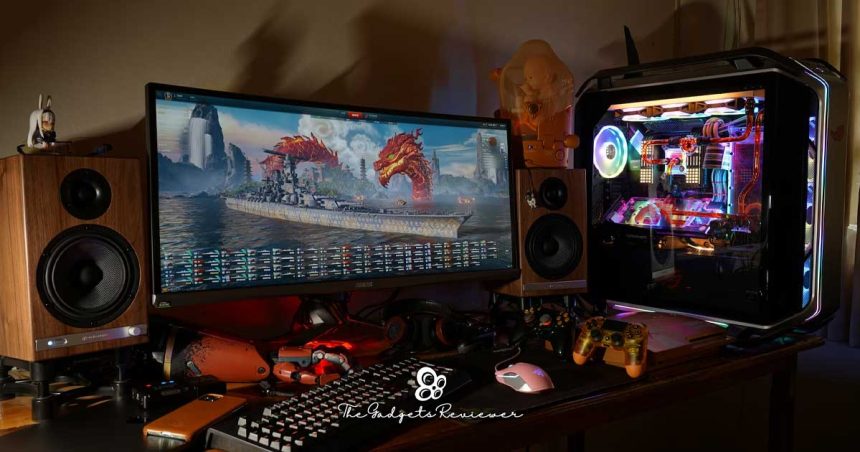Although you can buy one of the best gaming PCs and thus solve the dilemma of whether to buy or build a PC, building your own computer is often more rewarding. When you build a gaming PC yourself, you control everything from the exact make and model of the motherboard to the aesthetics of the chassis and the number of RGB fans you want to install.
Depending on the type of computer you are building, you can also save a few hundred dollars over the cost of purchasing a pre-built system, although this is not always the case in today’s market. OEMs, such as Dell, Asus, and HP, can easily get their hands on the most advanced graphics cards without having to pay extra as consumers do, hence the price difference between pre-built and home-built systems. has been drastically reduced. On the other hand, OEMs tend to cut corners when it comes to memory and storage or charge huge markups for them.
To help you build the best gaming or productivity PC for your budget, we’ve created a set of recommended component lists for different configurations. We’ve included budget rigs that cost under $500 and under $1,000, as well as mid-range, high-end, and super-high-end gaming rigs.
PC Building Considerations
As most hardware enthusiasts know, this is a difficult time to buy PC components, especially graphics cards. Fortunately, the situation has been improving and GPUs can often be found for sale in major online stores, albeit priced above their original retail price (MSRP).
Prices change quickly, so please note that the prices below were current at the time of publication, but could be different at this time.
We’re also going to recommend GPUs rather than specific brands and models of graphics cards. For example, we recommend an RTX 3060 Ti and link to a list of available cards instead of, for example, the MSI Ventus 3X RTX 3060. Cards with the same GPU have very similar performance, so given the issues of supply, you should buy the one that is available at the time you read this.
Also note that we don’t include the cost of an operating system, because you can get Windows for free or cheap. We also do not include the price of peripherals, such as a monitor, keyboard, or gaming mouse.
The best PC gamer configurations of 2023:
The best $500 gaming PC
| Component | Model | Price |
|---|---|---|
| CPU | Ryzen 5 5600G | $218 |
| Motherboard | ASRock B450M Pro4 | $79 |
| RAM | TeamGroup T-Force Zeus DDR 16GB Kit (2 x 8GB) 3200 MHz | $51 |
| SSD | WD Blue SN550 500GB | $49 |
| Case | Cooler Master MasterBox Q300L | $52 |
| PSU | Corsair CV450 | $39 |
| Heatsink | N/A, comes with CPU | |
| Total | $488 |
We hate to say it, but with GPU prices rising, it’s impossible to include a discrete graphics card in a $500 configuration, or at least a card suitable for gaming. Therefore, we recommend that you opt for the best integrated graphics card you can afford. In terms of processors, that translates into the AMD Ryzen 5 5600G. The Ryzen 5 features AMD Radeon Vega 7 graphics, 6 CPU cores, and a maximum frequency of 4.4 GHz. This APU also comes with AMD’s Wraith cooler included in the box, so we’ll save some money.
While we don’t expect fantastic frame rates in games, we should be able to play at 720p and perhaps go up to 1080p at low or medium settings in some less demanding games. In any case, you can always save up for a future GPU upgrade.
As for the motherboard, any budget B450 or B550 motherboard with an M.2 slot should do, but we chose the ASRock B450M Pro4 for its relatively affordable price rather than its features. If you can opt for a B550 board, you’ll get better bandwidth for the GPU and also the ability to one day upgrade to a fast PCIe Gen 4 SSD, something that’s too expensive for this build and not a priority at all.
To get the most out of our integrated GPU, which depends on system RAM, we need relatively fast, but cheap RAM, so we are going to use a 16 GB (8×2) 3200 MHz TeamGroup kit. Any pair of two 8GB 3200 MHz DIMMs will do, but this kit was the cheapest at the time of writing this article.
For our storage drive, we have chosen the WD Blue SN550, which is an excellent budget M.2 NVMe SSD, with a capacity of 500 GB. It has theoretical sequential read and write speeds of 2,400 MBps and 1,750 MBps respectively, which is much faster than a SATA drive and is truly amazing in this price range. However, 500GB doesn’t leave you much room for gaming, so if you can, consider spending an extra $40 or $50 for a 1TB SSD or even adding a SATA SSD later as a data drive.
Our case is the Cooler MasterBox Q300L because you can usually find it for just over $50 and it has a premium look, although its side panel is acrylic. It comes with a rear exhaust fan, which should be adequate for cooling this build. Any decent 450W power supply should be able to cope with this setup, and the Corsair CV450 is not only from a very reputable brand but is also 80+ Bronze certified for greater efficiency.
The best $1,000 gaming PC
| Component | Model | Price |
|---|---|---|
| CPU | AMD Ryzen 5 5600X (AMD) or Intel Core i5-12400 (Intel) | $209 – $234 |
| Motherboard | ASRock B450M Pro4 (AMD) or Gigabyte H610M S2H (Intel) | $79 – $99 |
| GPU | AMD Radeon RX 6600 or Nvidia RTX 3050 | $399 – $449 |
| RAM | TeamGroup T-Force Zeus DDR 16GB Kit (2 x 8GB) 3200 MHz | $51 |
| SSD | Samsung 970 EVO 1TB | $109 |
| Case | NZXT H510 | $79 |
| PSU | Corsair CV550 | $45 |
| Heatsink | N/A, comes with CPU | |
| Total: | $1000 – $1100 |
If you can stretch your budget to around $1,000, you can build a PC with the ability to run games reasonably well at 1080p resolution, and often at high settings. At the time of this article’s publication, an AMD Radeon RX 6600 or an Nvidia RTX 3050 card can be purchased for between $400 and $500. The RX 6600 is much faster and the better option, but it is usually more expensive.
Our recommended CPU for this build is the AMD Ryzen 5 5600X. This 6-core, 12-thread CPU can run at 4.6 GHz and draws a modest 65 W. We’re pairing it with the same B450 motherboard we used in our $500 configuration, but any AMD B450 or B550 board will work for this one. purpose. It comes with a decent air cooler included in the box so you don’t have to spend money on a CPU cooler.
The Ryzen 5 5600X is about the same speed as the Intel Core i5-12400, which is about $30 cheaper but requires a more expensive motherboard. So, if you prefer Intel, you can get the Core i5-12400 and an H610 motherboard. However, if you purchase the Radeon RX 6600 GPU and Ryzen CPU, you’ll get up to 15 percent more performance thanks to AMD’s Smart Access Memory (SAM) feature, which allows the processor faster access to memory on the CPU. GPU.
We’ll also keep the same 16 GB of RAM as in our cheapest configuration. There is no need to increase speed or memory capacity in this price range.
As for storage, we are going to use a 1 TB drive and a very fast one, the Samsung 970 EVO Plus, which cost $109 at the time of publishing this article. The 970 EVO Plus has read and write transfer rates of 3,300 and 1,700 MBps, respectively, and a 1 GB DRAM cache, which is a big jump over the DRAM-less WD Blue SN550, which has speeds of 2,400 and 1,750 MBps, respectively.
Our case is the NZXT H510, which was priced at $79 when we wrote this. We like the clean, sleek aesthetic of this box, which is available in white, black, or black and red. It also has a USB-C Gen 2 (10Gbps) connector on the front panel, along with a Type-A connector and a headphone jack. It comes with two built-in fans and has room for a 240mm front radiator if you want to go that route. This is a micro ATX case, so the space for expansion cards will not be as large as larger cases.
Finally, we have opted for a 550-watt power supply and, in this case, a Corsair CV550, although any decent 80-plus Bronze model will do just as well.
The best $1,500 gaming PC
| Component | Model | Price |
|---|---|---|
| CPU | Intel Core i5-12400 | $209 |
| Motherboard | Gigabyte H610M S2H | $99 |
| GPU | Nvidia RTX 3060 or RTX 3060 Ti | $649 – $900 |
| RAM | Patriot Viper Steel DDR4 32GB (2 x 16GB) 3200 | $127 |
| SSD | SK hynix Gold P31 2TB | $208 |
| Case | Phanteks P360A | $89 |
| PSU | Cooler Master MasterWatt 650 | $68 |
| Heatsink | N/A, comes with CPU | |
| Total: | $1500 – $1700 |
Now that we move on to a configuration really capable of playing at 1080p with high settings and even playing at 2K decently, we find ourselves with a budget of about $1,500, depending on which of the two video card options you choose. We recommend an Nvidia RTX 3060, which was around $650 to $750 at the time of this article’s publication, or the RTX 3060 Ti, which was around $800 to $900.
Our GPU comparison results show that the RTX 3060 averages 51 fps in 2K gaming tests, while the 3060 Ti averages 69 fps. Without a doubt, the 3060 Ti is worth the extra expense.
Our CPU for this build is Intel’s Core i5-12400, which was our fallback choice for the $1000 build but is an even stronger choice here where we’re using an Nvidia GPU and therefore can’t benefit from Shared Memory Access from AMD.
The Core i5-12400 has 6 performance cores and 12 threads, but none of the efficiency cores we see in most Alder Lake processors. The 12400 does not support overclocking and reaches a maximum speed of 4.4 GHz, but at this price, we are not looking to overclock anyway. This Intel processor comes with its own heatsink in the box, so there is no need to pay for a third-party one.
We’re going to use a relatively cheap motherboard with Intel’s mid-tier H610 chipset. The Gigabyte H610M board does not have support for PCIe Gen 4 SSDs and only has two DIMM slots, but it should work well enough for this configuration.
With our budget increasing, we are going up to 32 GB of RAM with the well-known and respected Patriot Viper Steel series. We are also going to use a 2 TB SSD drive with very high performance, the SK Hynix Gold P31. This M.2 drive promises sequential read and write speeds of 3,500 and 3,200 MBps respectively.
Our chosen chassis is the Phanteks P360A, which offers excellent thermals, a premium tempered glass side panel, and two included RGB fans. Our power supply is a 650-watt Cooler Master MasterWatt. This 80 Plus Bronze certified power supply is fully modular, so you only need to connect the cables you really need.










